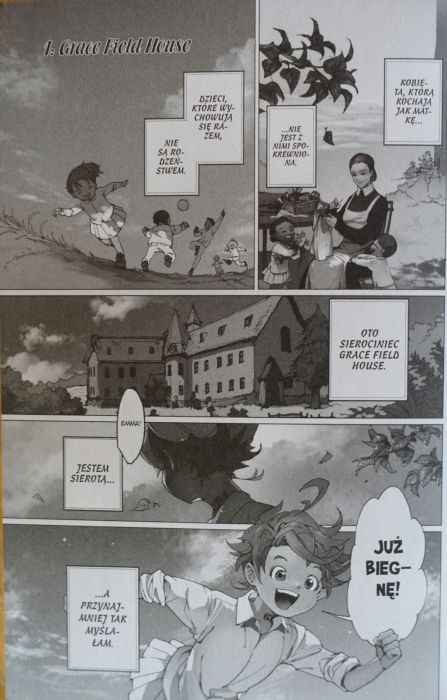At first glance, The Promised Neverland seems like a warm tale of children from an orphanage. The heroes of the series are surrounded by love and care, and the time spent with siblings is a series of almost uninterrupted fun. But it turns out very quickly how much appearances can be deceptive.
Life at Grace Field House
In the first volume, we meet the main characters – Emma, Norman and Ray, as well as the caretaker of the Grace Field House orphanage – Izabella and numerous supporting characters. The leading three kids are 11 years old and have extraordinary, but not supernatural abilities. The other pupils of the facility love them, but also admire them. Everyone loves Izabella, who they call mom. Unfortunately, we soon discover that Grace Field House is not as wonderful a place as readers and heroes may think, and Emma and her friends must find a way to deal with a situation that would rather overwhelm most of their peers.
Emma, Norman and Ray were skillfully introduced. Each of them has a slightly different character and their skills complement each other. Izabella was also professionally written – although it is worth noting that we get to know her personality and motivations more slowly than in the case of children’s characters.

A disturbing idea
Although the main characters of the series are only 11 years old, The Promised Neverland is definitely intended for an older audience. Already at the end of the first chapter, the disturbing secret of the orphanage is revealed to the readers, and the atmosphere grows heavier with the pages that follow. However, before everything is cleared up, the recipient may notice a disturbing signal in the form of numbers tattooed on the necks of Grace Field House residents.
In order not to reveal too much about the manga plot, let me just say that the kids are in great danger. Moreover, the knowledge they acquire turns their world upside down and makes decisions for them, the consequences of which are extremely far-reaching.

Clash of graphics and themes
The covers of the first two volumes of The Promised Neverland are much more joyful than their content. In the third installment of the series, the graphics on the jacket have a less positive overtone, but are still sweeter than one would expect from the comic’s content. Overall, Posuka Demizu’s line seems extremely positive. Theoretically, this may not suit the gloomy atmosphere, but in practice such a contrast significantly enhances the atmosphere of the piece.
It is worth noting here that the artist skillfully mixes works created in a “sweet” style with those that clearly indicate that the story being read is not a position for children. The whole thing makes a really good impression and fits perfectly.

Summary
The next volumes of The Promised Neverland are short, but full of content. The plot unfolds rapidly and the characters are very easy to like. It is true that at times the strategic skills of some characters seem to be extremely developed, but this does not prevent the reception of this title. As long as someone does not mind the heavy atmosphere and the threat to children, he should like this manga.

